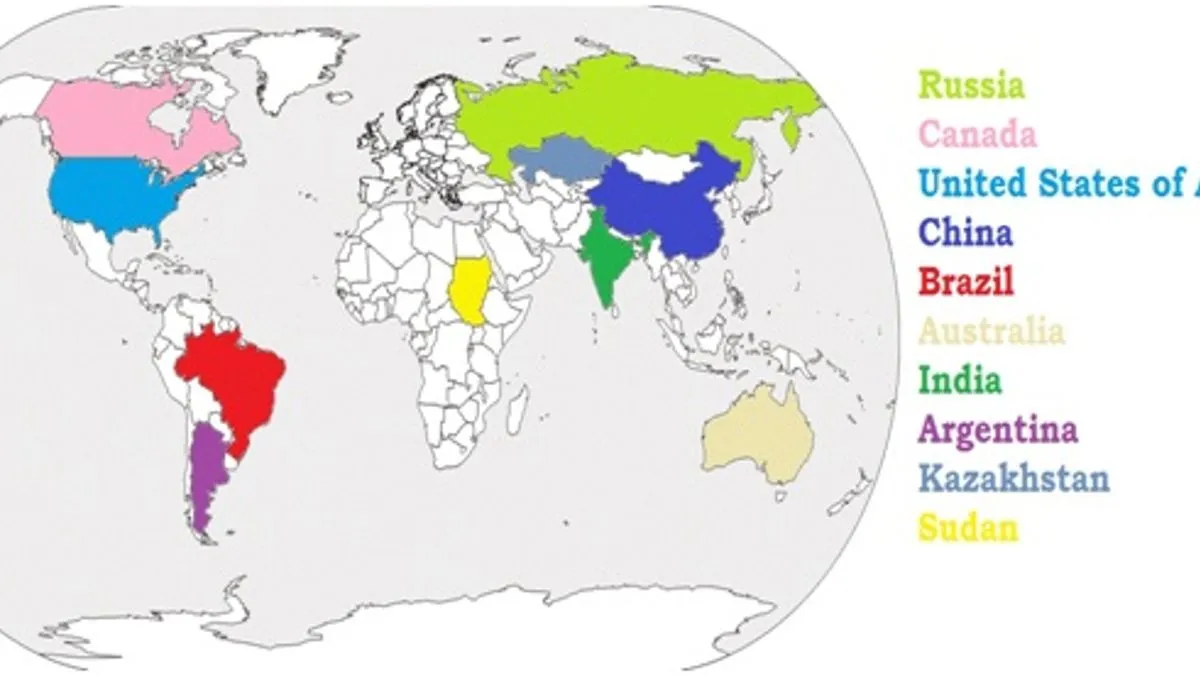When we talk about the vastness of our planet, it’s hard to overlook the enormity of some countries.
From expansive landscapes to diverse cultures, the largest countries in the world offer a glimpse into the sheer magnitude of our Earth.
In this article, we’ll take a journey through the top contenders for the title of the largest countries, exploring their unique features and what makes them stand out on the global stage.

1. Russia: The Giant of Eurasia
Russia, spanning across two continents, is undeniably the largest country in the world by land area.
From the snowy expanses of Siberia to the bustling streets of Moscow, Russia boasts a diverse array of landscapes and cultures.
With its rich history and vast natural resources, Russia holds a prominent place on the world map.
2. Canada: Wilderness and Wonder
Stretching from the Atlantic to the Pacific and reaching into the Arctic Circle, Canada is a land of breathtaking beauty and untamed wilderness.
From the towering peaks of the Rocky Mountains to the pristine lakes of Ontario, Canada’s vastness is matched only by its natural splendor.
3. United States: Land of Opportunity
With its diverse geography and vibrant cities, the United States ranks among the largest countries in the world.
From the deserts of the southwest to the forests of the Pacific Northwest, the U.S. offers a wealth of experiences for travelers and residents alike.
4. China: A Land of Contrasts
China’s sheer size is matched only by its rich history and cultural heritage.
From the bustling metropolises of Beijing and Shanghai to the remote villages of rural China, the country offers a fascinating blend of tradition and modernity.
5. Brazil: Amazonian Majesty
Home to the vast Amazon rainforest and some of the world’s most biodiverse ecosystems, Brazil is the largest country in South America.
With its vibrant culture, stunning natural beauty, and dynamic cities, Brazil captivates visitors from around the globe.

6. Australia: Down Under, Down Big
Although it may seem small on a map, Australia’s landmass is actually quite vast, making it one of the largest countries in the world.
From the iconic Outback to the bustling cities of Sydney and Melbourne, Australia offers a wealth of experiences for travelers.
7. India: Diversity and Depth
With its bustling cities, stunning landscapes, and rich cultural heritage, India is one of the largest and most diverse countries in the world.
From the snow-capped peaks of the Himalayas to the sun-drenched beaches of Goa, India’s beauty knows no bounds.
8. Argentina: From the Pampas to Patagonia
Stretching from the fertile plains of the Pampas to the rugged terrain of Patagonia, Argentina is the eighth-largest country in the world.
With its vibrant culture, stunning landscapes, and world-renowned cuisine, Argentina offers something for everyone.
9. Kazakhstan: Eurasian Expanse
Located in Central Asia, Kazakhstan is the ninth-largest country in the world by land area.
With its vast steppes, rugged mountains, and rich cultural heritage, Kazakhstan offers a unique blend of history, tradition, and natural beauty.
10. Algeria: Saharan Splendor
With its vast deserts, rugged mountains, and stunning coastline, Algeria is the largest country in Africa and the tenth-largest in the world.
From the ancient ruins of Timgad to the bustling streets of Algiers, Algeria offers a wealth of experiences for travelers.
Conclusion:
As we’ve explored the largest countries in the world, it’s clear that size is just one aspect of what makes these nations unique.
From the majestic landscapes to the vibrant cultures, each country offers its own blend of beauty, history, and diversity.
Whether you’re drawn to the snow-capped peaks of Russia or the sun-drenched beaches of Brazil, there’s a world of adventure waiting to be explored.

FAQs
- Which country has the largest population?
China currently holds the title for the most populous country in the world, with over 1.4 billion people.
- Is Russia part of Europe or Asia?
Russia spans both Europe and Asia, with the majority of its landmass located in Asia.
- What is the smallest country in the world?
The smallest country by land area is Vatican City, an independent city-state located within Rome, Italy.
- How many countries are there in the world?
There are 195 countries in the world today, including 193 member states of the United Nations and 2 observer states: the Holy See and the State of Palestine.
- Which country has the longest coastline?
Canada boasts the longest coastline in the world, stretching over 202,000 kilometers along the Atlantic, Pacific, and Arctic Oceans.
